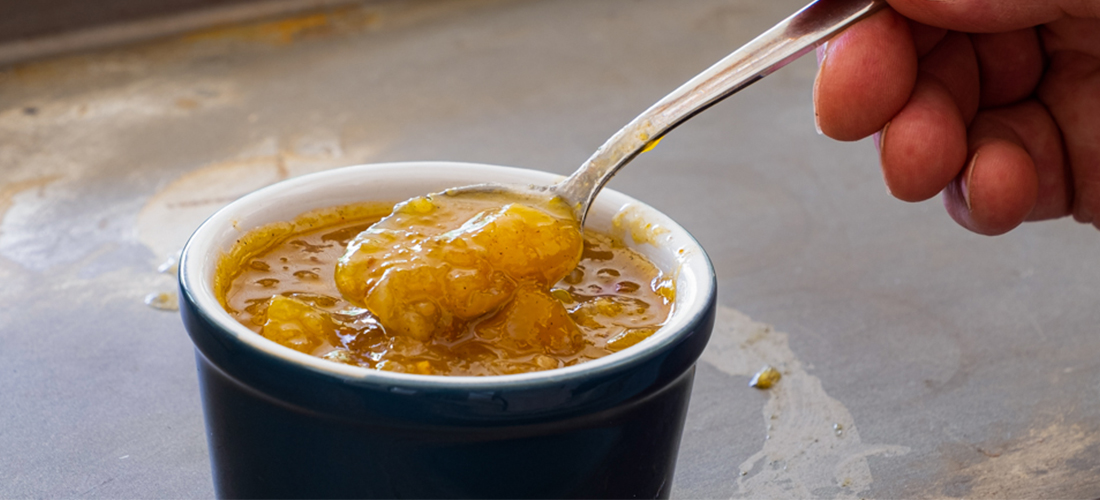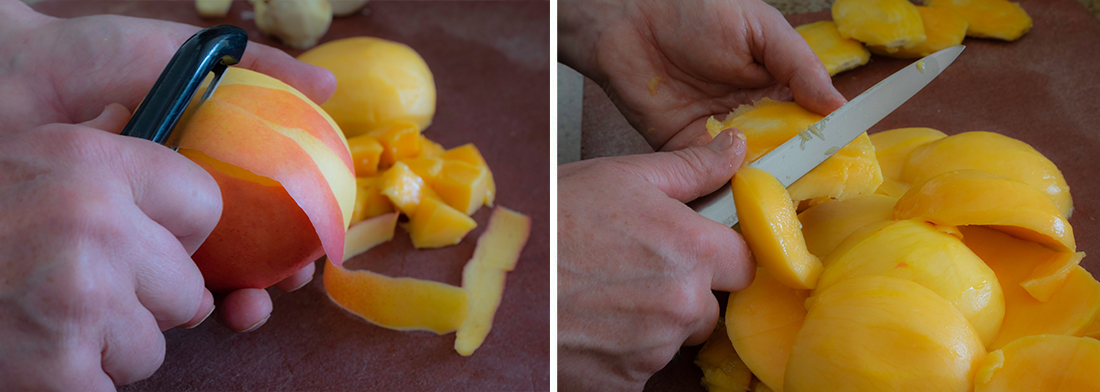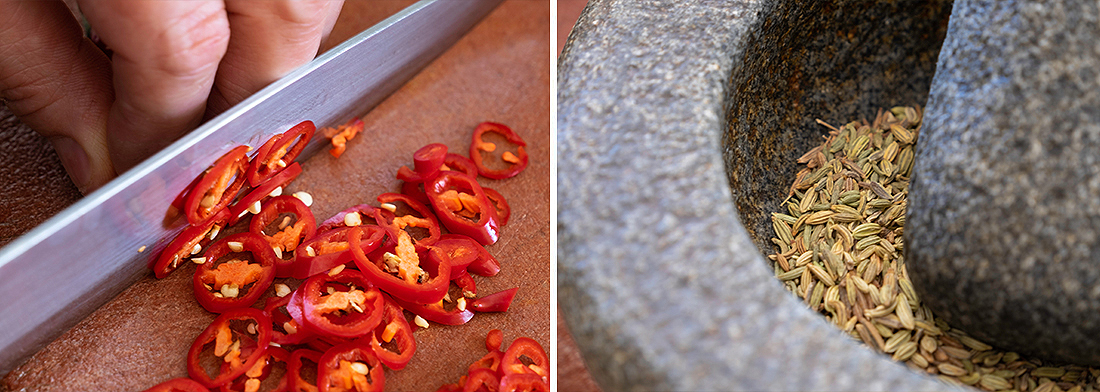Mango Chutney
- Pickles, Chutney, Relish & Sauces

Mango Chutney is the darling in our pantry and it never lasts long. Despite making multiple batches in peak season, when they are sweet, prolific and great value, the jars move quickly out the door and the empties recycled by family and friends in hopeful anticipation that’s there’s another jar for sharing. No Indian meal is complete without it, it lifts Mexican quesadillas and chicken, duck, turkey and fish dishes to the next level. Spread on cheese on toast, try with potato wedges and sour cream. The possibilities are endless. If you like it hot, more chillies can be always be added.
- Preparation Time:
- 50 minutes
- Cooking Time:
- 1-1.5 hrs
- Quantity:
- 9 x 275ml jars
PREPARATION
Warm sterilised sealable glass jars and lids.

INGREDIENTS
- 2 kg
- Mangoes, ripe, peeled, diced
- 1 kg
- Brown onions, peeled , diced
- 600 ml
- Cider vinegar
- 680g
- White sugar
- 340g
- Light brown sugar
- 60g
- Fresh ginger, peeled and finely chopped
- 10g
- Fresh garlic, peeled, finely chopped
- 10g
- Fresh red chilli, finely chopped
- 5g
- Cardamon seeds
- 5g
- Fennel seeds
- 5g
- Cumin seeds
- 5g
- Mustard powder
- 2
- Fresh limes, medium, zest
- 10g
- Salt
- 10g
- Citric acid

METHOD
With a vegetable peeler, remove the mango skin. Then using a shape knife remove the flesh from the stone and cut into 1centimetre cubes. Discard the mango stones. Peel and finely chop onions.
Lightly roast cardamon, fennel, and cumin seeds. Allow to cool and finely grind with spice grinder or mortar and pestle. Peel and finely chop the ginger and garlic. Finely chop the fresh chilli. If you want a spicy chutney leave the seeds in. For a milder heat, remove the seeds.
Place all the ingredients in a large preserving pan. Bring to the boil and simmer gently, uncovered, for approximately 1 hour or until the chutney is reduced a thick and luscious consistency and no excess liquid remains. Stir occasionally to prevent it from catching and burning on the bottom of the pan.
Remove from heat and place on a heat resistant board. Using a funnel, pour into warm dry sterilised screw cap sealable jars. Fill to approximately 2.5cm (1inch) from the top and seal while hot.
Label and store in a cool dark place in the kitchen or pantry. Allow the chutney to mature for at least 4 weeks before eating . Use within 1 year of making.
Once opened, store in the refrigerator and use within 3 months.
NOTES
- Choose clean ripe fruit. Do not use overripe and never use mouldy fruit or vegetables as this will produce a poor-quality chutney.
- For a chunky chutney texture, cut the mango into larger pieces. This will increase the cooking time.
- Lightly roasting the cardamon, fennel and cumin seeds will intensify the flavour and aroma of the spices.
- Simmering the chutney in an uncovered preserving pan will assist in reducing the moisture content during the cooking process. If the chutney is getting too thick but the mango and onions are not cooked ,the pan can be covered. Adjust as required.
- Stir occasionally to prevent the chutney from sticking on the bottom of the pan.
- The cooking time is an approximation only. Cooking time will depend upon, the size of preserving pan (the broader the pan, the quicker the evaporation), degree of fruit ripeness (the riper the fruit, the sweeter and juicer the initial chutney will be), and the degree of heat when cooking (the higher the stove heat setting, the greater the boil which will also increase the evaporation rate).
- For a hotter chutney, increase the chilli and include the seeds.
- It is important to wash your hands thoroughly after handling and de-seeding chillies. Chilli oil is easily transferred from the chillies to hands. If you touch your eyes or any delicate areas, the chilli oil will be transferred on contact and create a burning sensation.
- The type and colour of the sugar and vinegar used will affect the final colour and flavour of the chutney. Malt vinegar and brown sugar will produce very dark brownish red chutney with a more earthy/molasses background flavour, while white wine vinegar or apple cider and white sugar will produce chutney that has a fresher and brighter flavour and colour. This is a matter of personal choice. I have used a mixture of white sugar to retain the clean golden yellow colour and added some light brown sugar to add some depth of flavour.
- To test the chutney is cooked to the right consistency, spoon a little of the mixture on to a plate. The chutney should hold its shape.
- Towards the end of the cooking process, it may be necessary to stir regularly. It is important that the fruit does not stick to the bottom of the pan and burn. Your chutney will be tainted with a burnt flavour and it is not very pleasant.
Why is chilli so hot?
- The legendary heat comes from a natural compound, capsaicin, which develops and is concentrated in the white pith with some migrating to the seeds. The amount of capsaicin a chilli contains depends upon the chilli variety and growing condition. High temperatures and drought can increase capsaicin production as the chilli ripens. To control and reduce the amount of heat, use the most appropriate variety and amount of chilli, remove as much or little of the white membrane and seeds and vary the length of contact time with other ingredients while cooking to suit your taste.
- Chilli heat or pungency is measured in Scoville Heat Units (SHU) which was developed in 1912. The higher the Scoville rating the hotter the chilli. The ubiquitous Jalapeno varies between 2,500 – 10,000 SHU which is mild compared to the Habanero and Scotch Bonnets 80,000 – 150,000 SHU or the hottest chilli in the world, the Carolina Reaper, which has been measured at 2million SHU! Aptly named the Reaper; use with extreme caution. SHU was developed in 1912.
- Dried chilli develops an earthy, woody and nutty flavor complexity that is rare among other herbs and spices. Substitute dried chilli in recipes throughout the year, make your own special chilli powder blend with dried ground cumin, garlic and oregano or grind finely to make a hot chile powder.
